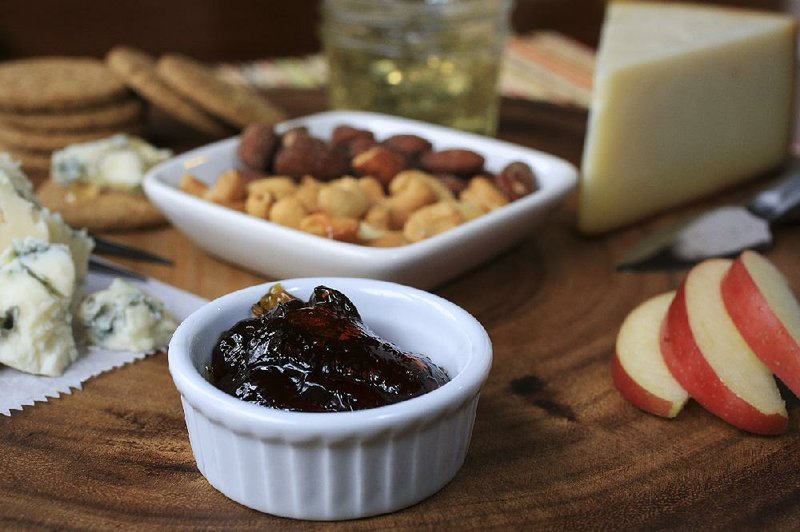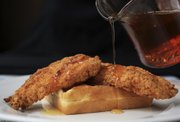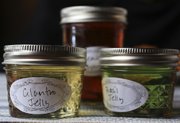Embracing unusual flavored jellies such as basil, beer or roasted garlic involves a bit of taste-bud reset. These are not dessertlike spreads meant for slathering on hot biscuits or mixing with peanut butter for classic sandwiches.
No, these spreads are destined for savory roles: glazing meat, drizzling over cheese or whisking into pan sauces.
That's not to say these uncommon jellies can't be enjoyed in traditional ways, although adjusted expectations may be required.
In flavors such as beer, garlic, basil and coffee, savory-inspired spreads deliver unexpected flavors suspended in sweetness.
Serving suggestions and ideas:
• Serve the jellies on a tray with crackers, nuts and an assortment of cheeses. We particularly enjoyed pairing herb jelly with blue cheese and porter jelly with smoked cheddar.
• A tablespoon of cilantro or basil jelly whisked with a few tablespoons of oil and vinegar and a touch of mustard creates a vinaigrette.
• Baked brie drizzled with peach ale syrup
• Vanilla porter jelly and hot breakfast sausage
• Coffee-jelly-glazed ham
• Porter jelly whisked into a pan sauce for pork chops
• Roasted garlic jelly, butter and a slice of salty cured meat such as proscuitto on toasted baguette
We used a Ball FreshTech Automatic Home Canning System (freshpreserving.com/auto-canner) to process our batches. The countertop appliance heats and holds the jars at the proper temperature and uses less water than a traditional boiling water canner and processes the jars at the required temperature for the appropriate time according to programmed settings.
All of the following recipes include instructions for using a traditional boiling water canner. For detailed, step-by-step instructions on preparing a boiling water canner, canning jars and lids, visit tinyurl.com/mnq9tsv.
Herb jelly is tasty served with cream cheese or in place of mint jelly with lamb.
Herb Jelly
2 cups fresh herbs such as basil, cilantro or lemon verbena
2 tablespoons unseasoned rice vinegar or distilled white vinegar
Pinch salt
3 1/2 cups granulated sugar
Pinch crushed red pepper flakes, optional (see note)
3 ounces liquid pectin such as Certo
Prepare canner, jars and lids.
Wash and drain the herbs, then coarsely chop and put in a medium saucepan. Use the bottom of a glass to crush and macerate the leaves. Add 2 cups of water, bring slowly to a boil, and boil for 15 seconds. Remove from heat, cover, and let steep 15 to 20 minutes.
Strain 1 1/2 cups of this liquid from the pan and pour through the strainer again into another large, deep stainless-steel or enameled saucepan. Add rice vinegar, a pinch of salt, the granulated sugar and crushed red pepper flakes, if using.
Over high heat, stirring constantly, bring mixture to full, rolling boil that cannot be stirred down. Add the liquid pectin and return to a full, rolling boil. Boil 1 minute. Remove from heat. Skim off foam using a large spoon. Pour the hot jelly into prepared jars, leaving 1/4 inch headspace.
Wipe rim clean with a damp towel. Center metal lid over jar. Screw band fingertip-tight, just until resistance is met. Place jars in prepared canner, ensuring they are completely covered by water. Bring to a boil and process 10 minutes. Remove canner lid. Let jars stand in water for 5 minutes, then remove to towel-lined table or countertop to cool undisturbed for 24 hours. Refrigerate any jars that did not seal.
Makes 4 (1/2-pint) jars.
Note: The crushed red pepper flakes give cilantro jelly a nice zip of subtle heat.
Recipe adapted from Reneesgarden.com
Roasted Garlic Jelly
3 whole heads garlic
1 tablespoon olive oil
1 tablespoons balsamic vinegar
1 cup dry white wine
2/3 cup water
1/2 cup golden balsamic vinegar
1 teaspoon whole black peppercorns, crushed
3 tablespoons lemon juice
3 cups granulated sugar
2 (3-ounce) pouches liquid pectin
Heat oven to 425 degrees.
Using a sharp knife, cut the top third off each head of garlic. Place the heads on a sheet of aluminum foil. Drizzle evenly with the olive oil and balsamic vinegar. Loosely wrap in foil. Roast 45 minutes. Open foil to vent and let stand until cool enough to handle. Once cool, squeeze the garlic pulp from the papery skin. Discard skin.
Place the pulp in a medium saucepan. Add the wine, water, golden balsamic and peppercorns. Bring to a boil over medium heat. Reduce heat and boil gently for 5 minutes. Cover, remove from heat and let steep for 15 minutes.
Transfer mixture to a dampened jelly bag or a strainer lined with several layers of dampened cheesecloth set over a large bowl. Let mixture drain, undisturbed, for 30 minutes.
Meanwhile, prepare boiling water canner, jars and lids.
Discard garlic solids. Measure 1 2/3 cups of the liquid. If necessary, add more water or white wine to make 1 2/3 cups. Combine the liquid with the lemon juice and sugar in a large, deep stainless-steel or enameled saucepan. Over high heat, stirring constantly, bring mixture to a full, rolling boil that cannot be stirred down. Stir in the liquid pectin. Return to a full, rolling boil. Boil 1 minute. Remove from heat. Skim off foam.
Quickly pour hot jelly into prepared jars, leaving 1/4 inch headspace. Wipe rim clean with a damp towel. Center metal lid over jar. Screw band fingertip-tight, just until resistance is met. Place jars in prepared canner, ensuring they are completely covered by water. Bring to a boil and process 10 minutes. Remove canner lid. Let jars stand in water for 5 minutes, then remove to towel-lined table or countertop to cool undisturbed for 24 hours. Refrigerate any jars that did not seal.
Makes 4 (1/2-pint) jars or 8 (4-ounce) jars.
Recipe adapted from Ball Complete Book of Home Preserving edited by Judi Kingry and Lauren Devine
Regular jelly is foamy. Beer jelly is unbelievably foamy. We learned the hard way that a 6-quart pot is too small for this recipe. We recommend using a stainless-steel or enameled stockpot.
Any beer can be used, but strong-flavored beers like stouts and porters, fruit-flavored beers or spiced beers work best.
Vanilla Porter Jelly
2 (12-ounce) bottles vanilla porter beer (we used Leinenkugel Snowdrift Vanilla Porter)
3/4 cup apple cider
4 cups granulated sugar
2 (3-ounce) pouches liquid pectin
Pour the beer into a stockpot. Refrigerate pot overnight or until beer is flat or mostly flat.
Prepare boiling water canner, jars and lids.
To the stockpot of beer, add the cider and sugar. Over high heat, stirring constantly, bring mixture to a full, rolling boil that cannot be stirred down. Stir in pectin. Return mixture to a full, rolling boil. Boil 2 minutes. Remove from heat and skim off foam. Pour into prepared jars, leaving 1/4-inch headspace. Wipe rim clean with a damp towel. Center metal lid over jar. Screw band fingertip-tight, just until resistance is met. Place jars in prepared canner, ensuring they are completely covered by water. Bring to a boil and process 10 minutes. Remove canner lid. Let jars stand in water for 5 minutes, then remove to towel-lined table or countertop to cool undisturbed for 24 hours. Refrigerate any jars that did not seal.
Makes 4 to 6 (1/2-pint) jars.
Recipe adapted from byo.com
This recipe is the result of a happy accident. Our first batch of jelly made with beer turned out too firm, so we decided to try reducing the pectin. The result was that the mixture didn't jell, but thickened to a syrupy consistency.
Peach Ale Syrup
2 (12-ounce) bottles peach ale (we used Blue Moon First Peach)
3/4 cup apple cider
4 cups granulated sugar
1 (3-ounce) pouch liquid pectin
Pour the beer into a stockpot. Refrigerate pot overnight or until beer is flat or mostly flat.
Prepare boiling water canner, jars and lids.
To the stockpot of beer, add the cider and sugar. Over high heat, stirring constantly, bring mixture to a full, rolling boil that cannot be stirred down. Stir in pectin. Return mixture to a full, rolling boil. Boil 2 minutes. Remove from heat and skim off foam. Pour into prepared jars, leaving 1/4-inch headspace. Wipe rim clean with a damp towel. Center metal lid over jar. Screw band fingertip-tight, just until resistance is met. Place jars in prepared canner, ensuring they are completely covered by water. Bring to a boil and process 10 minutes. Remove canner lid. Let jars stand in water for 5 minutes, then remove to towel-lined table or countertop to cool undisturbed for 24 hours. Refrigerate any jars that did not seal.
Makes 4 to 6 (1/2-pint) jars.
We tried making this jelly using a cold-brew coffee concentrate, but because the mixture must boil to jell, the results tasted burnt, and not in a pleasant caramelized way. After reading recipes for jelly bean jelly -- jellies made using extracts and flavorings -- we decided to give coffee extract a shot.
Coffee Jelly
2 cups unsweetened apple juice OR apple cider
3 1/2 cups granulated sugar
1 (3-ounce) pouch liquid pectin
1 tablespoon coffee extract
Prepare boiling water canner, jars and lids.
In a large, deep stainless-steel saucepan, combine the apple juice and sugar. Over high heat, stirring constantly, bring mixture to a full, rolling boil that cannot be stirred down. Stir in pectin. Return to full, rolling boil, stirring constantly, and boil 1 minute. Stir in extract. Remove from heat and skim off foam. Pour into prepared jars, leaving 1/4-inch headspace. Wipe rim clean with a damp towel. Center metal lid over jar. Screw band fingertip-tight, just until resistance is met. Place jars in prepared canner ensuring they are completely covered by water. Bring to a boil and process 10 minutes. Remove canner lid. Let jars stand in water for 5 minutes, then remove to towel-lined table or countertop to cool undisturbed for 24 hours. Refrigerate any jars that did not seal.
Makes 3 to 4 (1/2-pint) jars.
Recipe adapted from Ball
Food on 03/25/2015


